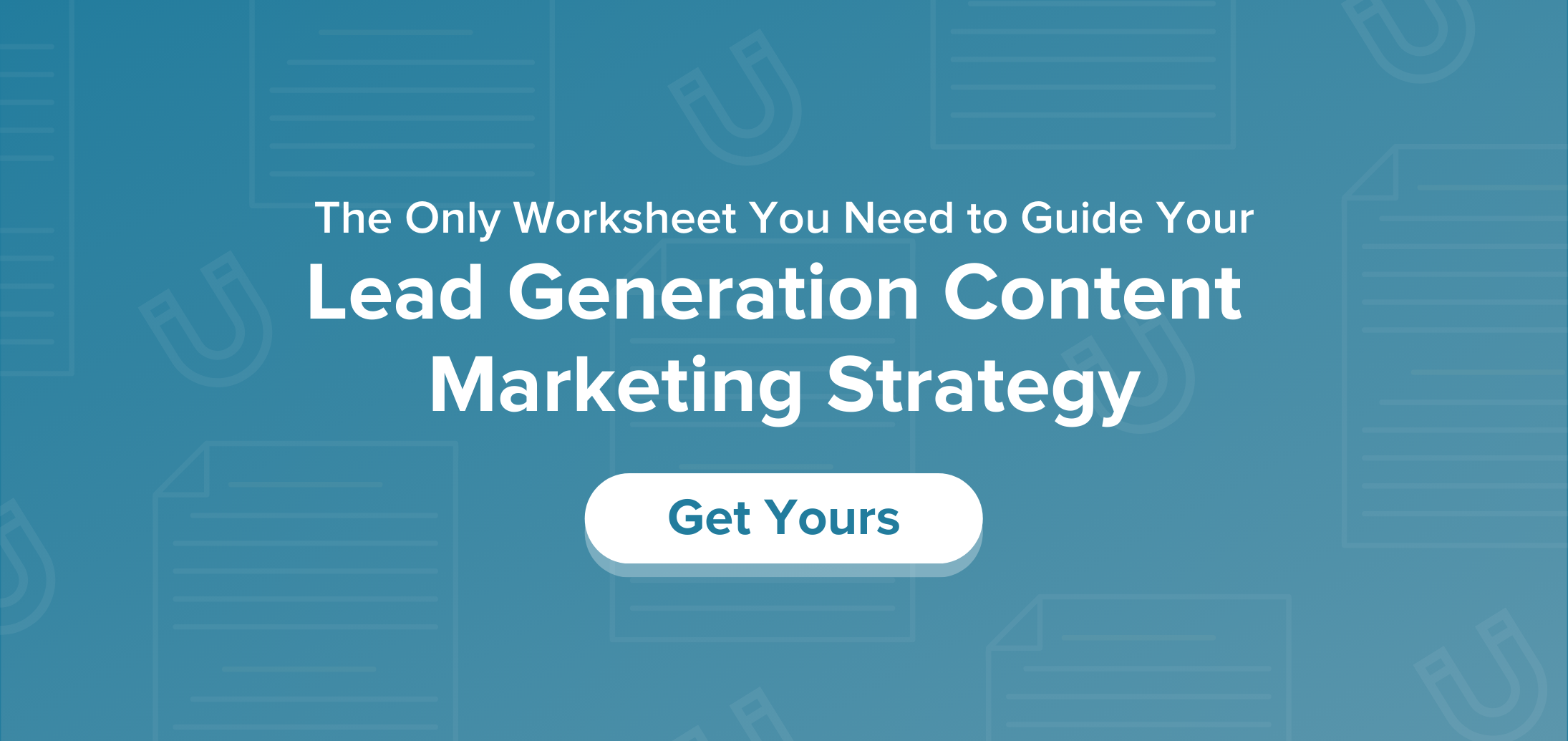Nearly 80% of marketers' primary goal for content marketing is lead generation, and over half of marketers spend at least half of their budget on lead generation tactics. If you're among these marketers who are doubling down on lead generation, it's crucial that you plan ahead to make sure you're maximizing your opportunity to see the results you're after.
Having a documented content marketing strategy is necessary for any business that wants to ensure alignment between sales and marketing. Of course, strategy documents take time to complete, but they give you a focus and something to refer back to as you progress through the year to ensure you make decisions with your strategy in mind.
Here at Influence & Co., we are a marketing company that specializes in content. A primary use for content is driving leads, so when we build our internal content marketing strategy, it has a heavy focus on utilizing content to drive leads. This document serves as our compass throughout the year as we make decisions and create content. It contains the most important aspects of our lead generation strategy, including our marketing key performance indicators, our ideal client profile, marketing-qualified lead parameters, the marketing initiatives we'll tackle, our content priorities, a breakdown of our marketing team members' responsibilities, and a snapshot of our budget.
6 Key Components of a Documented Lead Generation Strategy
To help you create, publish, and amplify your content to work toward your lead generation goals, I've broken down the components of our documented lead generation strategy. Map out these six elements to get started on your own:
1. Content Marketing Goals
My team would agree that I am constantly saying that marketing is built to drive sales. Because of this, lead and revenue generation are consistent main priorities for our internal marketing team. But those overarching goals are not specific enough for us to really work toward and achieve them, so we set goals around related niche areas where we can make and measure incremental progress. Examples of these goals include increasing:
- MQLs generated from our website and partner initiatives.
- Referrals from our partner network.
- The website conversion rate.
- The number of sales calls generated by our inbound sales development representative.
These more specific metrics all work together toward the greater goals of lead generation and marketing-generated revenue.
—
Still determining what your content marketing goals are?

—
2. Benchmarks and KPIs
A strategy is only as good as your plan to analyze your performance. In the past, marketing and PR fell into the "vanity metrics" bucket, but that is no longer the case. Marketing — especially content marketing — can have a measurable impact on companies' bottom lines.
The KPIs our marketing team is choosing to prioritize based on our goals for the year include:
- MQLs.
- Partner referrals and leads generated.
- Contact form submissions.
- Sales calls set up from marketing efforts.
- Monthly recurring revenue generated from marketing.
Along with the KPIs for the year, we also set benchmarks for those KPIs as well as other leading indicators. The KPIs that I've listed above are the numbers that have the biggest impacts on our bottom line, while our leading indicators are other performance analytics that help us gain insight into what we need to change or continue doing to achieve our KPIs.
Some of these leading indicators include:
- Traffic sources.
- Bounce rate.
- Visitors' time on page.
- CTA click rate and submissions.
- Email newsletter open rate.
- Email newsletter list size.
—
Measuring the impact of your content can be a challenge.

—
3. Ideal Client and MQL Profiles
While content marketing can be used for most B2B companies, we know from being in business for 10-plus years that our services tend to be more impactful in certain industries, so it's important for us to document our ideal client profile to ensure that the content we create and the leads we're bringing in align with what our ideal client looks like.
This client profile should include industries, company size, primary goals, revenue, and budget, to name a few characteristics. But remember: Once you've identified your ideal client, you don't just get to set it and forget it. Each year, reevaluate who your ideal client is, and update your documented strategy accordingly.
Along with the ideal client profile, we also recommend outlining your MQL profile. This is a profile that will also be changing, so it will be important to review this regularly as well.
Let's look at an example: We use HubSpot as our marketing automation system, so we utilize automated lead scoring. This is so helpful to our small team because it saves us time that would traditionally be spent manually qualifying leads. Automated lead scoring also allows us to score leads based on how they engage with our site.
When reviewing our MQL profile for 2022, we made the decision to only focus our lead scoring on leads' job title, annual revenue, and monthly content marketing budget. Over the past 10 years, our blog has become an educational industry resource, so we get a lot of traffic that's purely looking for education. While these people engage with our site and download a lot of content, they're not necessarily looking for content marketing services. This led to a discrepancy in the number of leads who were automatically categorized as MQLs and the number of leads who were actually qualified. By simplifying our automated lead scoring, we've decreased our total MQLs, but we know these leads are more qualified.
4. Marketing Tactics
More content marketing tactics are available than ever before, so it's important to document which ones you plan to utilize throughout the year. This will keep your team on track and allow you to appropriately allocate the tactics to ensure they get completed (or reprioritized if you discover that one tactic is delivering more ROI or faster ROI than another).
With all these tactics at your team's disposal, you need a way to prioritize what will get your attention and monetary investment. Our marketing team prioritizes tactics in this order:
- Lead generation
- Educating and nurturing leads
- Sales enablement
- Partner promotion
- Employee recruitment and retention
Here's an example of how we might use this priority list:
Let's say we get asked to write a guest-contributed article on the ROI of content marketing and we also get a request from another publication to write about how we built our core values. While both opportunities are great positioning, the first would have a greater impact on our lead generation efforts, and the second would have a bigger impact on our employee recruitment. Before turning away an opportunity, we would ask for a later deadline for the lower-priority item. But if we were in a situation where we could create only one, we would choose the "ROI of content marketing" opportunity because it more directly aligns with our first priority: lead generation.
For each tactic, we recommend including information on how you plan to measure success and the volume you expect to create.
—
Wondering how you can create the right content to generate leads?

—
5. Responsibilities Breakdown
We are a small marketing team, so to ensure our resources and talents are being maximized, we include a breakdown of each person's responsibilities as part of our documented strategy. We've found so much value in reviewing our processes and responsibilities each year to make changes to ensure the right person is completing the right part of each initiative.
For example, during our review of responsibilities this year, we actually decided to bring our partnership department under the marketing umbrella in order to utilize marketing resources for optimizing some of our communication with partners. This ultimately freed up time for our director of partnerships to spend more time building relationships, which we know has a big impact on our bottom line. This is now reflected in our documented strategy, and we'll keep reviewing these responsibilities each year.
6. Budget Overview
To make the documented strategy fully comprehensive, I would also recommend including a high-level view of the marketing budget. This is helpful to track throughout the year to see where money is going in relation to what was budgeted, and it can help determine whether the budget needs to be reallocated based on where results are being seen.
Final Notes
As you're developing your lead generation strategy, remember that this document should not be something you create at the beginning of the year and never refer to again. This strategy should guide every decision your marketing team makes to ensure that you're a united front working toward common objectives. Also, this should be a living document. If you discover that an element of your strategy is clearly not working, change it! The strongest marketing teams are strategy-minded and adapt as needed to achieve the best results.
Now that you have a solid lead generation strategy in place, it's time to get to work! Click below to download your free worksheet to help you implement content marketing tactics that generate leads for your business.











